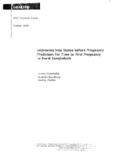| dc.contributor.author | Khambalia, Amina | |
| dc.contributor.author | Choudhury, Nuzhat | |
| dc.contributor.author | Zlotkin, Stanley | |
| dc.date.accessioned | 2019-11-26T09:14:21Z | |
| dc.date.available | 2019-11-26T09:14:21Z | |
| dc.date.issued | 2006-10 | |
| dc.identifier.citation | Khambalia, A., Choudhury, N., & Zlotkin, S. (2006, October). Improving iron status before pregnancy predictors for time to first pregnancy in rural Bangladesh. Research Reports (2006): Health Studies, Vol - XXXIX, 101–112. | en_US |
| dc.identifier.uri | http://hdl.handle.net/10361/13121 | |
| dc.description.abstract | It has recently been advocated that iron supplementation begin before childbearing. A key
operational issue is timely identification of !~males prior to pregnancy. The purpose of this
study was to examine factors associated with time to first pregnancy ( FP) and adolescent
pregnancy (AP). /\ cross-sectional survey was conducted in Gazipur. Bangladesh (April-May
2006) among ever married females aged < 50 y. Data on 603 females were analysed. Mean age
was 32 y .t 9. Only 15%, (7/47) of never pregnant females reported iron use in the past 6 mo.
Mean age at marriage was 17 y 1: 3 at marriage. 58% (322/556) of females were < l8 y at fP.
Median time from marriage to FP was 12 mo (range: 0-408). Multivariate hazard analysis
found risk of pregnancy increased by 13% for every y increase in age at marriage ( p<O.OOO I)
and decreased by 3% for every y increase in female's current age (p·~O.OOO I). Risk among
medical contraceptive users was 58% of the risk among non-users (p'-='0.000 I). Using
multivariate logistic regression analysis the probability of an AP decreased by 3% for each y of
marriage during adolescence (CI: 0.95-0.99), by 10% for every y increase in husband's age at
marriage (CI: 0.87-0.94), by 68% among female wage earners compared to non-wage earners
(CI: 0.16-0.64) and by SO% among medical contraceptive users compared to non-users (CI:
0.30-0.85). In this population females arc married at a young age with short time to FP
intervals. Pcriconceptional iron supplementation programs should target adolescents and
newly-weds. | en_US |
| dc.language.iso | en | en_US |
| dc.publisher | BRAC Research and Evaluation Division (RED) | en_US |
| dc.subject | Iron status | en_US |
| dc.subject | Pregnant women | en_US |
| dc.subject | Rural Bangladesh | en_US |
| dc.subject | Birth interval | en_US |
| dc.subject | Time factors | en_US |
| dc.subject | Periconceptional | en_US |
| dc.subject.lcsh | Nutritionally induced diseases | |
| dc.subject.lcsh | Women--Health and hygiene | |
| dc.subject.lcsh | Pregnancy | |
| dc.subject.lcsh | Health, Nutrition, and Population Program (BRAC) | |
| dc.title | Improving iron status before pregnancy predictors for time to first pregnancy in rural Bangladesh | en_US |
| dc.type | Research report | en_US |

